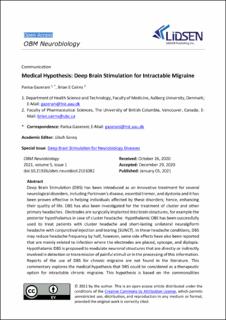| dc.contributor.author | Gazerani, Parisa | |
| dc.contributor.author | Brian, Cairns | |
| dc.date.accessioned | 2021-09-27T08:42:18Z | |
| dc.date.available | 2021-09-27T08:42:18Z | |
| dc.date.created | 2021-06-13T16:51:39Z | |
| dc.date.issued | 2021-01-05 | |
| dc.identifier.issn | 2573-4407 | |
| dc.identifier.uri | https://hdl.handle.net/11250/2783641 | |
| dc.description.abstract | Deep Brain Stimulation (DBS) has been introduced as an innovative treatment for several neurological disorders, including Parkinson’s disease, essential tremor, and dystonia and it has been proven effective in helping individuals affected by these disorders; hence, enhancing their quality of life. DBS has also been investigated for the treatment of cluster and other primary headaches. Electrodes are surgically implanted into brain structures, for example the posterior hypothalamus in case of cluster headache. Hypothalamic DBS has been successfully used to treat patients with cluster headache and short-lasting unilateral neuralgiform headache with conjunctival injection and tearing (SUNCT). In these headache conditions, DBS may reduce headache frequency by half, however, some side effects have also been reported that are mainly related to infection where the electrodes are placed, syncope, and diplopia. Hypothalamic DBS is proposed to modulate neuronal structures that are directly or indirectly involved in detection or transmission of painful stimuli or in the processing of this information. Reports of the use of DBS for chronic migraine are not found in the literature. This commentary explores the medical hypothesis that DBS could be considered as a therapeutic option for intractable chronic migraine. This hypothesis is based on the commonalities between cluster headache and migraine in terms of some shared symptoms, and potential overlap of underlying mechanisms. However, due to the absence of clinical evidence supporting the use of DBS in CM, the fact that disease-specific optimization of DBS parameters must be considered carefully, and considering the optimal CNS structures to target are currently unknown, it is concluded that this interventional and invasive technique should be avoided for CM for the present time. | en_US |
| dc.language.iso | eng | en_US |
| dc.publisher | LIDSEN Publishing Inc. | en_US |
| dc.relation.ispartofseries | OBM Neurobiology;Volume 5, Issue 1; Special Issue: Deep Brain Stimulation for Neurobiology Diseases | |
| dc.relation.uri | http://www.lidsen.com/journals/neurobiology/neurobiology-05-01-082 | |
| dc.rights | Navngivelse 4.0 Internasjonal | * |
| dc.rights.uri | http://creativecommons.org/licenses/by/4.0/deed.no | * |
| dc.subject | Deep brain stimulations | en_US |
| dc.subject | Migraine | en_US |
| dc.subject | Cluster headaches | en_US |
| dc.subject | Hypothalamus | en_US |
| dc.subject | Headaches | en_US |
| dc.title | Medical Hypothesis: Deep Brain Stimulation for Intractable Migraine | en_US |
| dc.type | Peer reviewed | en_US |
| dc.type | Journal article | en_US |
| dc.description.version | publishedVersion | en_US |
| dc.rights.holder | © 2021 by the author. | en_US |
| cristin.ispublished | true | |
| cristin.fulltext | original | |
| dc.identifier.doi | https://doi.org/10.21926/obm.neurobiol.2101082 | |
| dc.identifier.cristin | 1915453 | |
| dc.source.journal | OBM Neurobiology | en_US |
| dc.source.volume | 5 | en_US |
| dc.source.issue | 1 | en_US |
| dc.source.pagenumber | 1-20 | en_US |

